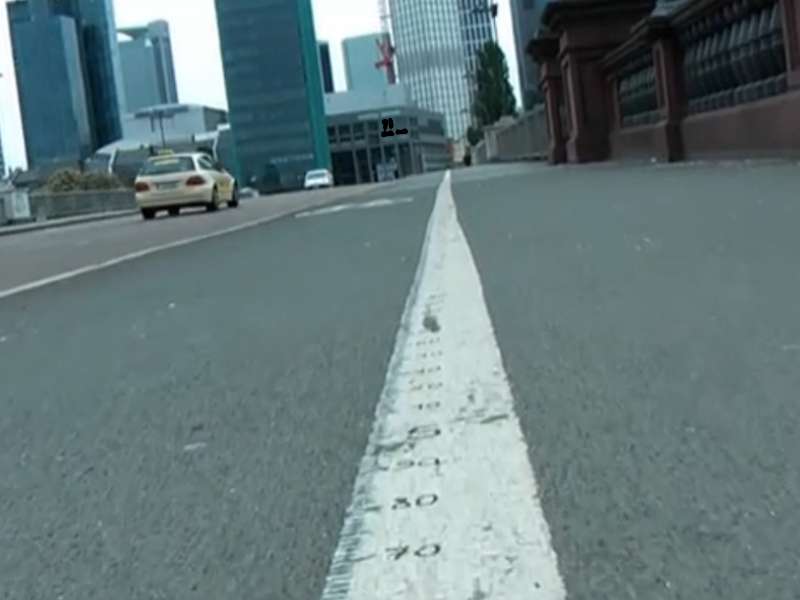
Accueil > Les rubriques > Images > So far, so close
So far, so close
Time and distance in the work of Bruno Di Lecce
, et
Toutes les versions de cet article : [English] [italiano]
The second appointment with Las Italias presents Bruno Di Lecce, artist and architect, who was born in Matera in Southern Italy and lives permanently in Germany. Memory and perception, space and time, identity and relationship with the other all blend in his works in measurements, virtual reconstructions, drawings and video performances that build a continuous developing path.
Backtrack often seems to have a negative connotation : following a backward path tastes like a defeat or nostalgia. However, turning back a path again, returning to your own roots is an intellectual and emotional impulse at the same time : it proves the ability to reflection and analysis, it often takes shape as the beginning of an evolution or a new start. It is able to produce surprising artistic results, as for Bruno Di Lecce.
From memory to the contemporary outskirts, the formative years
Born in Matera in 1980, Di Lecce lives and works in Berlin. He was an early artist, starting very young with life drawing and oil painting, reproducing the works of the great masters.
They were years of training and attendance of the discipline, leading to a first direction of research, that his dreamlike paint, Interno-esterno (Inside-Outside) , symbolizes very well : on the landscape of his native Murgia – a land of collective memory with its rock-hewn churches, ancestral worship and the motionless profiles of the rock - he silhouetted objects, symbols of childhood, of personal memory and of everyday life.

- Interno-esterno, olio su tela con foglia d´oro (oil on canvas with gold leaf), 100x70cm, 2000 (Matera)
A chair, as a symbol that alludes to the presence of an absence, becomes a recurrent element for a few years, a distinctive and -sometimes- obsessive feature, together with the annihilation of the perspectival space through the use of the gold leaf and the decomposition of the picture in multiple paintings which obtain a new totality within a single frame : a whole, within a plurality of fragments.
The experimentation with new techniques starts during his roman years, where Di Lecce attends the Faculty of Architecture. The impact with the big city creates a sense of estrangement : surrounded by the monuments and the tangible and looming evidences of a thousand-year history, he loses his reference points.
The eye cannot rest, as it wanders lost and frightened. The painting becomes a return to the roots, a backward path along the memory.
The represented objects on the surface of the painting, this time not canvas or board but perforated cardboard covered with gold leaf, become a research of familiarity, nearly a counterpoint to the alienation of the metropolis.
The turning point is precisely one of the objects coming - not just metaphorically - from his own attic in Matera : a metal tool, whose function was unknown to the artist, depicted in the painting Senza Titolo (Untitled). From that moment on, his research focuses not on familiarity and the everyday life anymore but on the depersonalization and lack of identity of places.

- Senza titolo, olio su cartone con foglia d’oro (oil on cardboard with gold leaf), 100x70, 2001
The endless outskirts of Rome, with its desolate urban landscape, becomes the new horizon of the pictorial look of Di Lecce, who in his wanderings (almost a negative of the "country walks" by Richard Long) focuses right on places that conflict with Rome and its unique monuments : isolated roads, bridges, stations, crossing points, alienating and anonymous places, which bring the unmistakable traces of human settlement with their desolation.
Scalo San Lorenzo, an old abandoned station under the east bypass of Rome, in the midst of trains yard, old trucks and waste, became (like the attic in Matera) the privileged viewpoint of the city. The painting of Di Lecce becomes rapid and direct in order to offer an archetypal nature, an almost monumental aura in spite of their desperately ordinary character of non-urban places to what the artist describes as "nomadic landscapes”, and the painting itself veers off towards an abstraction that you can never say total. And, most importantly, his painting takes shape from photography, in a construction process of the work that, on the one hand, shows traces of the influence of Abstract Expressionism and its dripping (but without seeking its gestural intent, rather than linking to its signs imprint, detached from any narrative intent) and on the other allows the construction of the pictorial image from the de-construction of the photographic one.
This process of dematerialization and re-materialization of the image starts an experimentation with new techniques (in the years between 2004 and 2006), which leads the photographs to interact directly on the canvas, in collages where the memories of the past and the search for identity are combined. Di Lecce starts from small family photos - shots with the traditional model posing - to which he overlaps fragments of objects. The portrait of his mother (almost a memory of Boccioni or an unconscious homage to him) on whose face appears a rusty old boiler is emblematic.
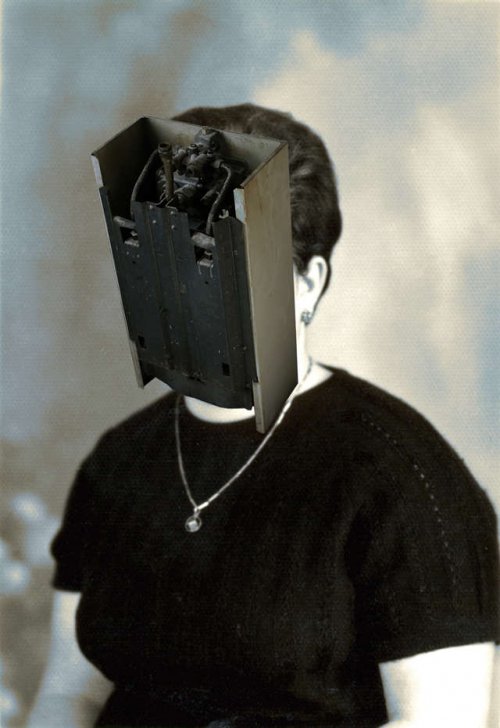
- Mamma, collage, 60x40cm, 2004
The procedure of collage is not hidden, rather it is amplified by the titles of the images, that are the names of the photographed family members. The "masks" resulting from these collages and the urban landscapes are included in the artist’s first solo exhibition in the gallery AAM Architecture Modern Art (Rome), entitled Identity and contamination.
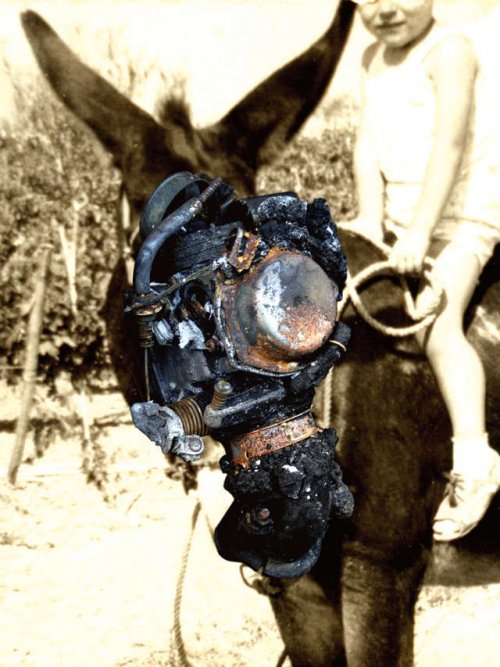
- L’asino di Rocco, collage, 60x40cm, 2005
The combination of paintings and photographs arouses interest but also controversy in the artistic Rome environment, because of the deep difference between the images realized with one or the other technique. A desired and remarked difference in honor of the assumption that the medium is the message : painting, as the site where constructing the image becomes an opportunity to "dig" the canvas, to find its deepest part that is the white surface ; the photograph as the place dedicated already to the deconstruction of the image (as it is "dug out" from the time or saturated by the past and belonging to another space-time) becomes the cue to recreate it overlapping fragments from others images.
The transition from "found" photographs to taken ones is short. However, the way he captures image follows an atypical procedure : Di Lecce embraces the camera but shoots without looking through the viewfinder. It is a way to prioritize the random image and to search deliberately for the error, almost the research of the "incident" to be fixed on the canvas and to transcend the limits of representation of the reality which remains -as an object of shooting- the core of the work-painting.
The artist, in his intellectual restlessness, interests in conceptual art and meet Francesco Careri, the author of Walkscapes - Walking as aesthetic practice (which is a cornerstone text for the development Di Lecce’s poetics) and founder of Stalker, an organization engaged in researches and actions within urban marginal areas, abandoned or under transformation places called “Actual Territories”, considered as the "negative" of the built city.
This encounter leads him to reflect on the way in which his work is proceeding along the path of representation, or how his analysis of the place is linked to his own personal perception : the landscape paintings are inhabited, the photographic collages represent individuals lacking specific social characteristics, the emphasis is always placed on a private symbolic universe.
Regarding that time Di Lecce said : « Even if I was looking for a “nomad look” I did not know any nomad or any marginal community living in the outskirts of Rome. My interest was still linked to the construction of the image, to think through images and, ultimately, to the frontal perspective plane. But [after meeting Careri ed] I realized I was working on the point of view and on the looking subject, not on his social or geographical origin, but on the nature of the gaze. And I was interested in a shifting point of view ».
Looking for a new dimension : Time in Berlin.
The awareness of the potential for the development of his research direction is accompanied by a significant personal change. After graduation, Di Lecce looks for a position as an architect : by chance he goes to Berlin, a city that he knew only through the films of Wim Wenders and the study of its most famous architectures.
The urban voids, he was looking for in the outskirts of Rome, gain a temporal dimension. On the streets of Berlin, Di Lecce is able to perceive the whole spirit of the German twentieth century : from its cultural greatness and artistic fervour during the Twenties and Thirties to the Second World War, from the destruction of the bombing to the construction of the Wall, until the difficult process of reunification of the country. For the artist the absence of what has been swept away, first by the Second World War and after by the Cold War, is a heavy presence that the more you remove, the more it becomes tangible.
Untersuchung des Abwesenden (Survey on Absence) arises this way ; it is a troubled project focused on the Palast der Republik, a large multipurpose building in East Berlin which housed a cultural center and the parliament of the German Democratic Republic. It was a modernist building, in which the ideologies from of the Soviet constructivist current and the Bauhaus were synthesized.
Bruno Di Lecce - Untersuchung des Abwesenden from TK-21 on Vimeo.8’00
Defined by the artist -on the basis of Foucault- a "utopia localized", the Palast was the symbol of a past that the city did not want to see anymore, and as such, during nearly five years, it was dismantled and reduced to powder. The video Untersuchung des Abwesenden is a 3D virtual reconstruction of the Palace into which he mixes the images of the demolition site (filmed by the artist every day for two months), archive videos and photographs, music, speech and sounds that emphasize the impossible tour, suspended between space and time.

- Terra rimossa, 29,7x45,82cm, 2010 (Berlin - Berlino)
Besides the video, the theme of the "presence of absence" can be found also in the shots Terra Rimossa (Removed Ground) and L’ombra del Sole (The shadow of the sun). Lecce often chooses to work on the same project with multiple techniques, in relation to the specificity of each medium.
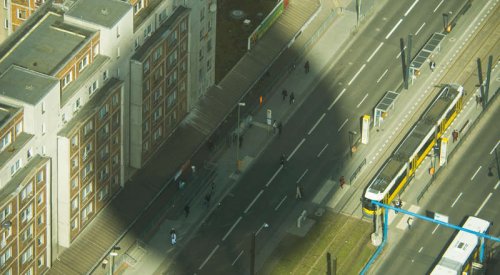
- L’ombra del sole, fotografia digitale (digital photoghaph), 10x188cm, 2009 (Berlin - Berlino)
It is also the case of Musterstadt (literally "model city"), a site specific installation in Chemnitz (2012) made up of a physical part (a suitcase covered with PVC) and a video. Overall the work arises from the reworking of the story of the city : almost completely destroyed during the Second World War, it was rebuilt as a symbol of socialism and had assumed the name of Karl-Marx-Stadt.
The project of Di Lecce is focused on the period after the fall of the Wall : Karl-Marx-Stadt takes its name back Chemnitz and, according to the vision of the artist, it has been almost annihilated by the disappearance of an ideology it was dominated by for several years.
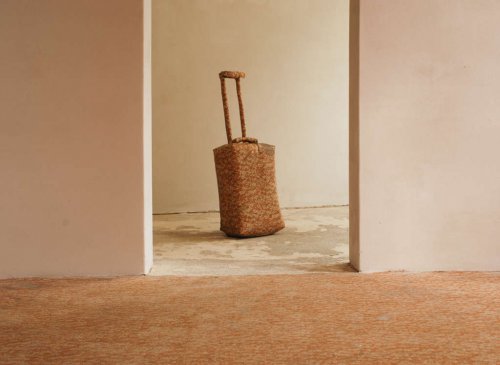
- Musterstadt, Installazione - Installation (pvc, trolley), 2012 (Musterstadt)
The suitcase, a common trolley is coated with PVC taken from the floor of the exhibition space. This material brings the typical texture of the socialist period, thus calling to mind the past, but the support on which it is applied suggests the expectation for a movement (Is it a leaving ? Is it a coming back ?).
The video was filmed by a camera mounted on the trolley itself that was taken around the city. The title "Musterstadt" plays with the meaning of the word that has defined the identity of Chemnitz as a "model city" during the communist era. However, in this case, Muster (in German “model”) simply refers to the material of which the city is made of – as it is shot by the camera - shifting this way the focus from the ideological dimension to the material one.
Bruno Di Lecce - Musterstadt from TK-21 on Vimeo.7’52
For each project, the choice of the medium is accompanied by a strong and inevitable influence of his education : in fact, both the special type of graphic sign and the recurring presence of numbers and distances come from architecture. This is particularly evident in the work Emserplatz (2012), divided into an environmental installation and a photograph.
The installation, made with sand and water, shows a portion of public space which people usually enjoys without awareness, that is the area between the square and the driveway.
The photographic work is conceived as a development of the installation and puts it through : the measure built on the square expresses the length of the environment -13.751 meters in 1:1 scale - but, in the picture that portrays the same measure expresses the size of the photographic paper on which it is printed (13.751 cm). Also in this case the use of two media for the same project is aimed to obtain two specific results and, if on the one hand the photograph documents the installation, on the other hand the installation returns a measure of the photo.
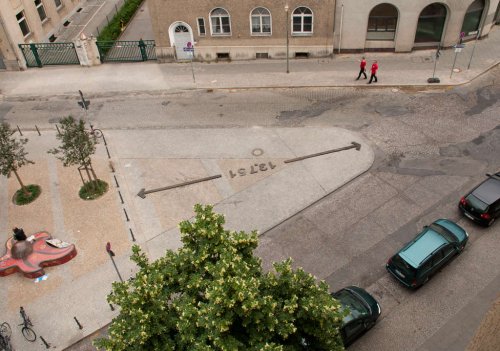
- Emserplatz, stampa su carta fotografica (photograph), 29,7x21cm, 2012 (Berlin - Berlino)
The combination of the various elements -installation, photography and video- tries to balance the weaknesses belonging to the different means of expression, when evaluated individually. The limit inherent the nature of each of them is often the origin of Di Lecce’s work.
The space and the perception as distances to read into the world
During the years, the reflection on the relationship between mankind and environment becomes a central theme in the artist’s poetics, it ramifies both in the sense of a (presumed) objective and universal dimension, which is the measurement, and in the personal attitude, linked to private.
166.499 km circa (nearly 166.499 km) in 2007 is the first work in which measurements appear. It is composed of several photographs that reconstruct the trail drawn by a plane in the sky. On the image it is indicated the actual length of the path traced, obtained by multiplying the average speed of a plane to the time it takes to describe the contrail. The line, which the same Di Lecce leads visually to A line made by walking by Richard Long, takes on a very different meaning from the action of the English artist, opening a real reflection on the nature of space and its conventional representation, looking for a short circuit between objectivity and perception.

- 166,499 km circa, stampa lambda (lambda print), 198x47cm, 2007 (Rome - Roma)
The measures attempt to add to the image a physical space, through the actual measurement of the distance travelled. However, they contain in themselves the negation of that intent, as it is air to be measured, whose nature denies any physicality.
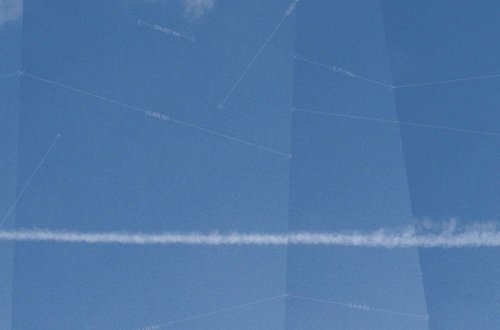
- 166,499 km circa (part.), stampa lambda (lambda print), 198x47cm, 2007 (Rome - Roma)
In addition, the sky path the airplane flies on is opened and flattened on a plane, in a geographical representation which recalls the principles of Ptolemy and manipulates the perceived reality to make it understandable.
The measure itself is an abstraction, as it is subject to change over the course of the centuries. The oldest system devised by man as order of magnitude is his own body, for which the measure always retained a central role : the units of measure were in fact spans, feet, steps. The metric system, now almost universally accepted, it is rather free from any anthropogenic reference.
Along this research it is also Metro sbagliato (2010, Wrong Meter), in which the Dada spirit, that builds almost an "object of affection", undermines the claim objectivity of measurement : as it is made of centimeters that succeed disorderly, the meter is still a measuring instrument but it is only able to measure itself. The convention that claims to represent reality objectively is – shortly - tied to the subjectivity of perception.

- Metro sbagliato, oggetto (object), dimensione variabile (variable size), 2011 (Berlin - Berlino)
A sort of counterpart to the object-meter can be found in the public intervention and the related video titled Main Bridge (2013), made in Frankfurt. In this case, the artist has placed on the dividing line of the bike path a progressive numbering, making it similar to a meter and thus creating an original measurement tool. The white strip, which identifies the boundary established in the city space for a private place (for bikes, in this case), changed its nature and takes on a new meaning through the creative intervention.
Bruno Di Lecce - Main Bridge from TK-21 on Vimeo.10’20
The analysis of the environment is not confined to a reduction to an abstract principle of distance or its manipulation to overthrow or change its elements. It prefigures the search for an interrelation with the human being, to stimulate awareness of his presence in the world, a reflection on the ability and the opportunity to change it. It seems to assume, according to Di Lecce, a sense of discovery of identity that leads the individual to relate on with the self, the others and the community a deep level.
Rediscovering, through space, the dimensions of time, of interiority and values.
A poetic interpretation of the place and its specific nature is to be found in Polvere eri e polvere vedrai (2009 -Dust you are and dust you shall see- Fondazione SoutHeritage per l´arte contemporanea Collection, Matera) an installation merely conceptual starting from its implementation. The artist has created a site-specific installation in the chapel of the Purgatory of Palazzo San Gervasio (Matera), "at distance", that is to say providing clear instructions and delegating the implementation to others.
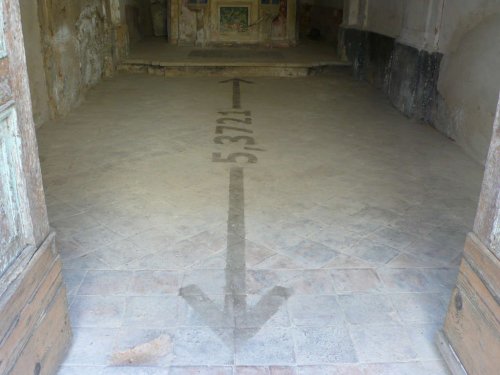
- Polvere eri e polvere vedrai, installazione (site specific installation), dimensione variabile (variable size), 2009 (Matera)
In this work, the distance between the entrance and the altar of the chapel is plotted on the floor with dust, as a symbol and witness of the past. This measure, on the one hand metaphysically represents the distance between the outside world and the spiritual one, and on the other - through the four decimal numbers - suggests a perception of space, which tends to the infinitely small, almost overshadowing a reference to scientific surveys. Eventually, the title, designed to paraphrase the words of God speaking to Adam dismissed from Eden in Genesis (Dust you are and dust you shall return), leads from a future dimension to a present one, from a spiritual projection to the immanence of the vision.
A human scale. Space and time as a personal dimension
The claim objectivity of measurement put into crisis by the artist’s work, it is fallacious as exhausting the task of interpreting and clarifying the relationship between man and his environment. One may only relies on a personal one, that is, to assign the task to seize and critically address the issue to one’s private dimension, pledging one’s own experience and, often, one’s own body.
The video 90 miliardi di passi (2010, 90 billion steps) arises this way : here the fusion between the past and the present, as suggested by the interaction between photography and moving image, by the ancient gesture of preparing the dough, actualized by the surveying, and by the shots of a vanished past, yet geographically present, redials the dimension "beyond the image" as suggested by the voice of the girl child who gives the measure of what she knows. The 90 billion steps, from which the work takes its title, represent the greatest distance that she is able to conceive. A remote subjective and personal distance that gives at the same time a measure of the relationship between the self and the world.
Bruno Di Lecce - Main Bridge from TK-21 on Vimeo.4’30
The tradition and the life experience come back in Mappa in movimento (2010, Moving map), a video that is also a tribute to "Chiena", which is a popular tradition of Campagna (Salerno), where every summer the river Terza is diverted by an artificial canal to cross the city center. This folk custom was born in an unknown time to clean the streets, it has been codified in the nineteenth century and, since 1982, has become an arts and culture festival.
Bruno Di Lecce - Mappa in movimento from TK-21 on Vimeo.2’04
In Di Lecce’s video the distances between objects and people are shown graphically by creating a perceptual short-circuit between the moving object, the space in which it moves and the flow of images. The visual map built through the distances identified this way loses its adherence to reality as the flow of images progresses, becoming the memory of a passage, or the mental map of the distances traveled on the image by each, involuntary, actor.
The tale becoming a visual map is the basis for the installation Paesaggio (2012, Landscape), a long sequence of words that describe, in a blurred sequence, all the things observed during the journey between Pietra Iaccata and Armento (in Basilicata).

- Paesaggio, penna su carta (pen on paper), 2012 (Armento, Basilicata)
The writing, sometimes incomprehensible due to the irregularities of the road and the speed of the car, becomes pure sign, freed from the conventions of language to represent only the relationship between the environment and the body in the act of crossing it.
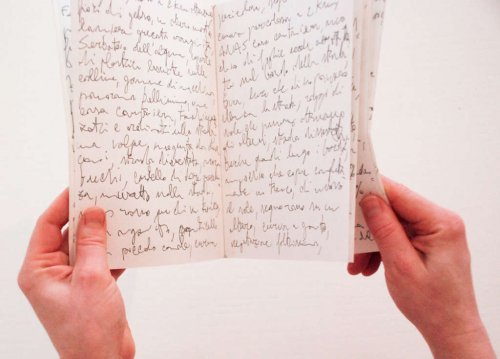
- Paesaggio (part.), penna su carta (pen on paper), 2012 (Armento, Basilicata)
A similar action - but focused on the drawing and not on the writing - is the core of the work We are never alone (2009), a performance that, along with the video Viaggio sul Danubio (Journey on the Danube) and La settima Porta (The Seventh Gate), is the project presented in Skopje (Macedonia) for the XIV Biennial of Young Artists from Europe and the Mediterranean. The three works represent a sort of trilogy of the travel, intended as a crossing, planning and memory.
The performance background is a video installation composed of three asynchronous projections of a single video shot during the journey between Berlin and Skopje, and it takes body through the action of drawing the outlines of moving images on the far wall, which, this way, plays the dual function of the projection screen and the registration surface for the traces of landscapes and action filmed during the trip.
Bruno Di Lecce - We are never alone from TK-21 on Vimeo.18’34
The line drawing - due to the frames speed – struggles to track the outlines of images, and the final result, which is visible only at the end of the performance, seems almost a catharsis for the troubled attempt to secure them, turning thereby into trace and memory.
Bruno Di Lecce - Viaggio sul Danubio from TK-21 on Vimeo.8’28
A similar action enliven the video Viaggio sul Danubio (Journey on the Danube), which was developed during the thirty miles of navigation on the river, through the camera –that films the landscape passing by the window- and the pen that traces the contours on the transparent glass surface.
The attempt to reconstruct a space-time continuum is also reflected in the performance and in the video La settima Porta (The Seventh Gate), whose starting point is the foundation of the city of Skopje that took place, according to the legend, on the skull of a giant who, thanks to a spell, would open the seven orifices of the face to give rise to the seven roads that connect the inside to the outside of the city.
Bruno Di Lecce-La Settima Porta from TK-21 on Vimeo.18’45
This time, the journey begins from the Berlin Wall, former GDR gate to the East, and continues through Bratislava, Vienna, Budapest, Novi Sad, Belgrade, up to the "seventh gate", or Skopje. Along the way, the boundaries disappear and the crossing of the territory is accompanied by offhand performances in various places, giving the video the meaning of documentation of the actions -all made with ephemeral materials- and providing an interpretation of the trip as "duration". At the same time, the project is ideally also an excuse to draw the new boundaries of the heart of Europe, after the geo-political changes of the last decades.
The representation becomes action
The relationship between man and the environment, the construction of identity through the past and the present (individual and collective), the increasing awareness of the importance of the body in the world lead Di Lecce to new experimental techniques, which involve tools typically used by an architects, such as glossy paper, on which, in the work Inconscio (2011, Unconscious), the artist engraves the traces of the surrounding environment through a frottage process.
This technique enables a tactile perception of the place, that - as suggested by the title- leads him to operate in an unthinking, unconscious way. The final result is a sheet of 50 meters on which you can find both the map of the place that the artist explored and his own subconscious. In this way, he opens himself to the art, somehow breaking in the boundary between inner and outer world.
The images obtained are not organized into a predetermined structure : instead, they remain suspended in the limbo of recognition, the search for identity. The roll -through the sequence in which they are impressed- is the only thing that makes them perceived as a unique form.

- Inconscio, Frottage su rotolo di carta da schizzi (Frottage on transparent paper), 33,5x5000 cm, 2011 (Matera)
A similar tension to the encounter between action and representation can be found in the video L’abyme (2012), which the artist has worked to with four people : two cameramen, Marcella Di Palo and Nunzio Papapietro, and two photographers, Luisa Lapacciana and Sar Sehgal, who followed him during the performance.
Frottage, which became part of a collective action, builds the work together with the film footage and the roll of paper, winding along the path, becomes an expressive medium on a par with the video. The movie and the path build the map and vice versa, as well as the body, the roll and the camera are the means through which the landscape is imprinted in the course of the action.
Bruno Di Lecce - L´Abyme from TK-21 on Vimeo.10’09
A greater degree of conceptual complexity is provided by Rilievo 1 (2012, Survey 1), the site-specific video installation created in Erfurt in Germany, that is also the first of a series of similar actions that affected the city of Copenhagen, Galway and Frankfurt.
The call to create a redevelopment of the square of the theater, now abandoned, to save it from demolition, is the origin of the work, where the glossy paper passes from frottage support to means to reading the world around us. The artist walks with the roll in front of him, like a blind man, and uses it to "see" the reality imprinting it on the architectural and the urban environment, thus to make them part of a visual, tactile, intellectual stimulation.
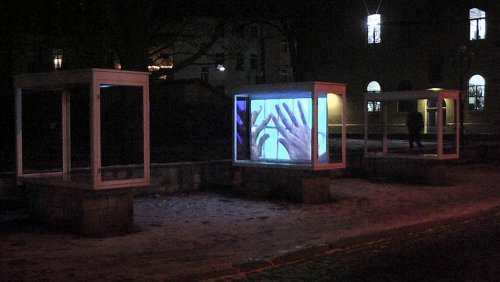
- Rilievo 1, Video installazione (video installation), 2012 (Erfurt)
The action of printing the city on the sheet not through the sign, but through the sense of touch, or "bundling" for a while everything around him, on the one hand is an invitation to expand perception and on the other hand, since the paper gloss is often used to draw objects in different scales, can be interpreted as a representation of reality in a 1:1 scale.
The body becomes a main tool : it is a tactile look to the world, the environment and the vehicle is fit for the perception of others. The roll, in turn, is a white screen that, obstructing the view, becomes an element of partial and mobile vision ; it reconstructs the urban space in folds, cuts and gestures that only occasionally let a glimpse of the world beyond the paper.
The action is divided into three phases : looking, feeling and understanding, in a process that ideally reverse Christo and Jeanne-Claude’s one : instead of modifying the landscape, hiding it from view for a known period of time, Di Lecce packs the individual elements of it for a while to make them visible, to underline the structure, to highlight the contours and details, without ever letting see its entirety. What is represented on the sheet is not a project, but rather the act itself.
Bruno Di Lecce - RILIEVO 1 from TK-21 on Vimeo.14’32
The perception as a way to tell the world from a critical sense
Another significant direction of the development of Di Lecce’s poetics highlights a critical look at the world, sometimes tinged with bitter irony, which becomes explicit in works such as Le coste di Lampedusa (2011, Lampedusa Shores), a work on an image of a boat full of migrants.
The three-coloured trail following the boat offers s disarming simple reading, suggesting the end of the journey, didactically indicated in the title. The two hands tracing seem to accompany the boat, pointing out the moral duty to welcome migrants and shadowing at the same time the sad news events that testify to how that duty is neglected and betrayed. The photograph, a "found" image dramatically familiar, portrays a humanity without distinction, regardless of the specific story of each migrant.

- Le coste di Lampedusa, Intervento su fotografia, Autore della fotografia sconosciuto, (Drawing on photo paper, The author of the photo is unknown), 17,3x26cm, 2011 (Berlin - Berlino)
A subtle irony is found in the video work The Boom remake, produced together with Claudia Olendrowicz. The starting point is offered by the eponymous film directed by Vittorio De Sica in 1963, a decade in which Italy experienced a rampant economic growth.
In the film, the protagonist Giovanni Alberti (a young Alberto Sordi) is in trouble with his building company. In order to save his company and his marriage, he agrees to sell one of his eyes to a wealthy manufacturer blinded by an accident with quicklime. The video is a caustic mirror effect with the film. It opens with the opening image of the film, manifestly extracted from youtube, and it spreads over frames extrapolated (and subtitled) that refer to images -taken again from the Internet- regarding Frankfurt, the city that is a symbol of the vast German building and speculation boom that has generated significant growth in real estate prices.
During De Sica’s film, the protagonist -before giving the eye- tries in vain to borrow money to rehabilitate the company. The only one to offer it is his mother, but unfortunately it is not enough. The images of Frankfurt, the symbol of the euro and a map of the city act as a counterpart to this particular scene.
Together with the frames of the Italian Sixties’ simplistic opulence (fur, status symbol of middle-class woman, the endless line of cars, the icon of a popular national welfare), the symbols of the European Economic Community and its crisis parade : the bills of exchange stroll up the report on international monetary crisis, trademarks neon flowing over the landscape of the German city with its buildings of steel and glass, as threatening emblems of power. Alberto Sordi’s voice offering a real-estate speculation to the rich Commander Busetti on the images of Frankfurt seems to offer an explicit reference to the estate speculation in the German city.
Bruno Di Lecce - Il Boom Remake from TK-21 on Vimeo.8’01
A similar irreverent intent is readable even in installations such as Errore Campione (2009), which was established under the project Incompiuto Siciliano (Unfinished Sicilian), a workshop with the collective group Alterazioni Video presented at Manifesta 7.
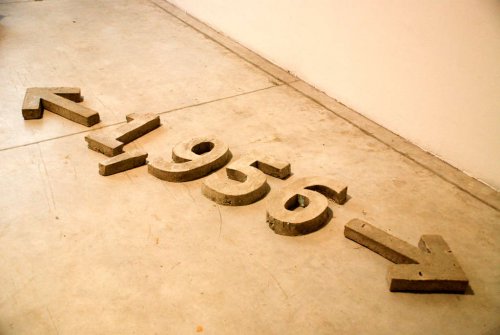
- Errore campione, installazione - cemento armato (installation - reinforced concrete), 1,956 m, 2009 (Milano)
The work starts from idea that the project error, which has been the main cause for great works such as stadiums, swimming pools, hotels and infrastructure of the City of Giarre are unfinished, and it is a paradoxical attempt to rise this error to a basis of a new architecture, which finds in the error its unit of measure and in the unfinished Sicilian city its full expression. The figure assumes a sarcastic double reading : it is both readable as 1,956 meters as 1956, year of the first unfinished work in Giarre.
The corpus of the work of Di Lecce - through the themes of memory, space, time, all confronted with irony and critical spirit, by combining images and action, urging all the nuances of perception - faces an investigation on human beings and the space they live in, pass through, change, represent.
It is an analysis that was suspended between the past and the future, ultimately configuring itself as an investigation about being-in-the-world and the actions of the individuals that changed it. And tracing the boundaries through different means of expression, by reading the forms, crossing it with your own body, you can only expand the understanding and awareness of those who experience it.
Voir en ligne : Bruno Di Lecce
Translated by Antonella Opera
You can see also :
https://vimeo.com/345082790
https://vimeo.com/345082596
https://vimeo.com/345082620
https://vimeo.com/345082663
https://vimeo.com/345082699
https://vimeo.com/345082717
https://vimeo.com/345082725
https://vimeo.com/345082746
https://vimeo.com/345082755
https://vimeo.com/345082769

